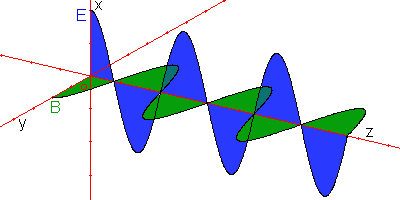To benefit fully from this page which contains interactive figures built with the software of geometry GeoplanW and GeospaceW you must give the responsability a page HTML on the site of the CREEM (Experimentation and Research center on the Teaching of Mathematics). On the other hand you do not need this software to read them. To make knowledge with this procedure in addition very fast implement and very light click on the imagette below. You will find all information there on this software and the means of remote loading.
 |
The undulatory character of the light was stated for the
first time by Huygens in 1678. Work of Fresnel largely developed
these ideas by the study of the phenomena of diffraction and
interferences. Maxwell in 1876 connected the undulatory
character of the light to electromagnetism by writing the equations
which the fields check electric and magnetic which are propagated in
the vacuum at the same speed as the light. He concludes from it
that the light is of nature electromagnetic. |
 |
The plane light waves are characterized by electric fields and magnetic E and B respectively which one can considérér separately as the sum of two perpendicular fields which are propagated according to the normal direction in the plan which they form.
|